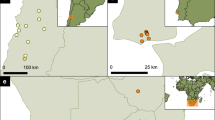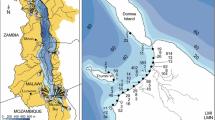Summary
The black Portuguese millipede, Ommatoiulus moreletii, an exotic species first reported in Australia in 1953, shows a pattern of initial eruption and subsequent decline in abundance following its introduction to sites in South Australia. Comparative sampling of new, erupted populations and older, declined populations was done in an attempt to find testable hypotheses to account for the decline. We report on laboratory and field experiments which show that a native rhabditid nematode appears to be the causal agent for the decline of populations of O. moreletii in South Australia. Implications for the biological control of introduced species are discussed in terms of this work.
Similar content being viewed by others
References
Baker GH (1978) The distribution and dispersal of the introduced millipede Ommatoiulus moreletii (Diplopoda:Iulidae) in Australia. J Zool 185:1–11
Baker GH (1985) The distribution and abundance of the Portuguese millipede Ommatoiulus moreletii (Diplopoda:Iulidae) in Australia. Aust J Ecol 10:249–259
Caughley G (1970) Eruption of ungulate populations with emphasis on Himalayan Thar in New Zealand. Ecology 51:53–72
Elton CS (1958) The ecology of invasions by animals and plants. Methuen, London
Fenner F, Ratcliffe FN (1965) Myxomatosis. Cambridge University Press, Cambridge
Lawrence RF (1984) The centipedes and millipedes of Southern Africa: a guide. Balkema, Rotterdam
McKillup SC (1988) Behaviour of the millipedes Ommatoiulus moreletii, Ophyiulus verruculiger and Oncocladosoma castaneum in response to visible light; an explanation for the invasion of houses by Ommatoiulus moreletii. J Zool 215:35–46
Myers JH, Iyer R (1981) Phentoypic and genetic characteristics of the European cranefly following its introduction and spread in Western North American. J Anim Ecol 50:519–532
Pimental D (1963) Introducing parasites and predators to control native pests. Can Entomol 95:785–792
Poinar GO (1983) The natural history of nematodes. Prentice Hall, New Jersey
Poinar GO (1986) Rhabditis myriophila sp. n. (Rhabditidae: Rhabditida), associated with the millipede Oxidis gracilis (Polydesmida: Diplopoda). Proc Helminthol Soc Wash 53:232–236
Author information
Authors and Affiliations
Rights and permissions
About this article
Cite this article
McKillup, S.C., Allen, P.G. & Skewes, M.A. The natural decline of an introduced species following its initial increase in abundance; an explanation for Ommatoiulus moreletii in Australia. Oecologia 77, 339–342 (1988). https://doi.org/10.1007/BF00378039
Received:
Issue Date:
DOI: https://doi.org/10.1007/BF00378039




